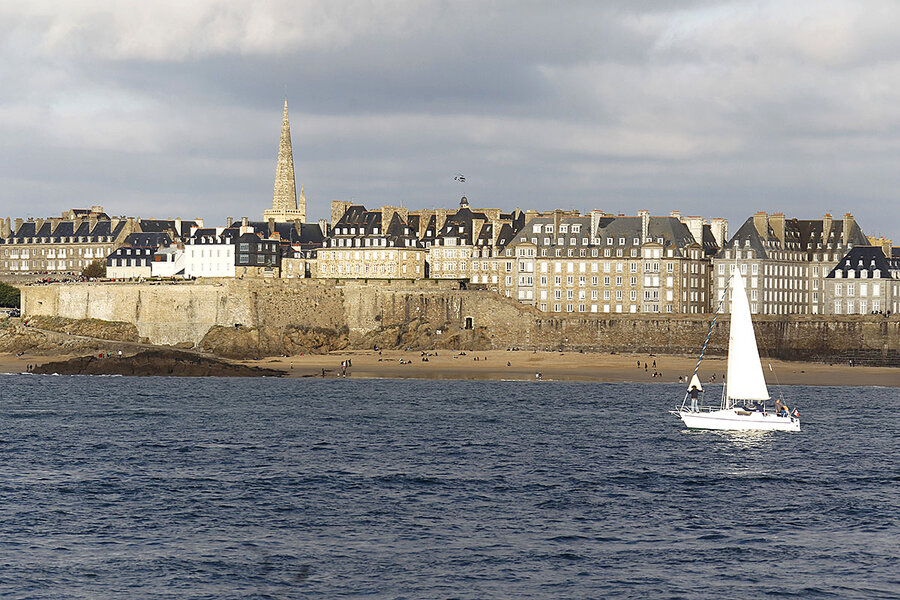France fights flight to big cities with funds for smaller towns
Loading...
| Cherrueix and Saint-Malo, France
The main road through this charming Breton town separates stone cottages from a pale green marsh that leads to the sea. But in Cherrueix, neither the beach nor the picturesque farmland have been enough to attract fresh faces to live here.
After François Goblé retired this March, the town and surrounding area of 5,000 inhabitants were left with one primary care physician. “I was working from eight in the morning until 11 at night,” says Dr. Goblé. “After 45 years as a doctor, it was impossible to continue in this way.”
Cherrueix is just one example of a “medical desert” – where the number of doctors is 30 percent lower than the national average in France. This is especially a concern for elderly patients or those with reduced mobility. It’s also a symptom of a larger problem in France and across the globe: An increasing number of small towns are struggling economically and demographically to remain competitive in the face of urbanization. As more young people move to major city centers, the vibrancy and economic viability of small and medium-sized towns are slowly dying. Now, local leaders, grassroots efforts, and €5 billion in state aid are working to reverse the trend.
Why We Wrote This
With high unemployment and empty storefronts, France’s smaller towns aren’t functioning well. The government hopes an investment of €5 billion in 222 communities will help attract younger residents and revitalize city cores.
“The problem is jobs in many small towns,” says Marc Ivaldi, research director at the Toulouse School of Economics. “It’s difficult to keep doctors and other professionals in these areas, plus transport costs are going up, so people are inevitably leaving for larger cities.”
Enhancing the core
France’s small towns have long had an image of enchanting tranquility for tourists and city dwellers alike. And while a quarter of the population live in small or medium-sized towns and many French still invest in second homes in the countryside, living full time in such areas has become increasingly less attractive.
To combat the exodus to larger cities, in March the government named 222 towns that will receive €5 billion ($5.7 billion) over the next five years – to revitalize city centers, create jobs, and improve transportation and quality of life.
Through the “Heart of the City Action” plan, so far more than 500 projects across France are under way. The town of Louviers, in Normandy, has enlarged and enhanced sidewalks and offered free parking to bring more business back to the city center. The north-central city of Chartres plans to create new housing and several cultural centers.
Some cities got a head start with local initiatives. Saint-Malo, a popular Breton beachside hangout for Parisians looking to beat the summer heat, has been attempting to attract more young people, many of whom have been pushed out because of climbing housing prices in the city center. They’ve begun offering tax breaks to first-time homeowners as well as putting more funding into schools and cultural events like music festivals – measures City Hall says will inevitably lure young couples. (According to INSEE, the national statistics bureau, 60- to 74-year-olds account for the largest segment of the town’s 47,000 residents, and there have consistently been more recorded deaths than births from 2007 to 2016.)
Working against such initiatives are harsh realities – many small towns have lost industries essential to economic survival, with employers moving to larger cities to improve operating costs and find workers.
“Deindustrialization in the last 40 years is definitely a major cause,” says Emmanuel Martin, an independent economist based in the south of France. “Many small towns relied on one industry or factory and when it closed down, what could they do?”
A knock-on effect has been the trend toward hypermarkets and commercial zones on the periphery of small towns, generating competition for small businesses in town centers. And as the state invests more into tramways and metro lines in cities, and less into roads to connect small towns with larger ones, people are finding themselves increasingly isolated.
Creating new balance
Maxime Lebigot is a cardiology nurse at a local hospital in Laval, a town between the Brittany region and Paris. Laval is part of the government’s Heart of the City Action plan, and has seen a consistent drop in population over last decade. Mr. Lebigot says that the hospital staff is severely overworked owing to the demands of an aging population and a lack of general practitioners.
“They’ve gotten rid of dozens of hospital beds and the ER is constantly clogged up,” says Lebigot. After he was told his son would wait months for a doctor’s appointment, Lebigot and his wife, Elodie, headed up the Mayenne regional branch of a citizens’ rights group whose specific aim is to tackle the medical desert problem. “There are enough doctors in France in terms of numbers, but they are very poorly divided up.”
According to DREES, a state-run statistics body, around 8 percent of French – or 5.3 million people – lived in a medical desert in 2017, with the most affected regions in the east of the country. Here in France’s northwest region of Brittany, one initiative proposes making it easier for replacement doctors to become permanent fixtures in their towns, while another in the Vendée region uses virtual visits with doctors to treat some patients. In many regions, doctors are coming out of retirement to deal with the lack of practitioners.
Professor Ivaldi, the economist, says that paying doctors to live in deprived areas could be one solution, but that more money must be invested into small and medium-sized towns in general to boost their vitality – instead of dealing with each symptom individually.
“We need to create more schools and public services outside big cities, and that costs more because local tax rates have increased a lot,” says Ivaldi. “We used to have more harmonized development [between small and large cities] but now it’s more expensive to maintain forests, roads, and infrastructure outside the city, plus this is being covered less and less by the state.”
Mr. Martin says that – although an unpopular idea to most – adjusting the minimum wage to reflect the cost of living regionally could help balance out the divide between small and large cities, eventually making products and services cheaper in smaller towns. Right now, France’s minimum wage – at nearly €1,500 per month ($20,400 per year) – is one of the highest in the world and is the same whether you live in Paris, Périgueux, or Pesmes.
But Martin, who himself lives in a small town, says that the effects of urbanization are not necessarily surprising nor should they always be viewed as a negative. “People are leaving but isn’t it the natural, evolutionary process?” he asks. “Towns have to answer the needs of the people and if they’re not able to do so, it’s part of life.”






